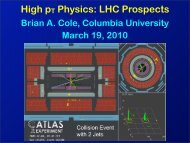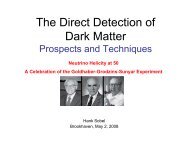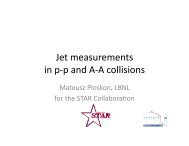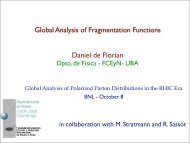One flavor QCD Abstract - BNL theory groups - Brookhaven National ...
One flavor QCD Abstract - BNL theory groups - Brookhaven National ...
One flavor QCD Abstract - BNL theory groups - Brookhaven National ...
You also want an ePaper? Increase the reach of your titles
YUMPU automatically turns print PDFs into web optimized ePapers that Google loves.
I. INTRODUCTION<br />
<strong>QCD</strong>, the non-Abelian gauge <strong>theory</strong> of quarks and gluons, is now generally regarded as the<br />
underlying dynamics of strongly interacting hadrons. It is a very economical <strong>theory</strong>, with the<br />
only parameters being the overall scale, usually called Λ qcd , and the quark masses. Indeed, in the<br />
zero quark mass limit we have a <strong>theory</strong> with essentially no parameters, in that all dimensionless<br />
ratios should in principle be determined. With several massless quarks this <strong>theory</strong> has massless<br />
Goldstone bosons representing a spontaneous breaking of chiral symmetry. The fact that the pions<br />
are considerably lighter than other hadrons is generally regarded as a consequence of the quark<br />
masses being rather small.<br />
The one <strong>flavor</strong> situation, while not phenomenologically particularly relevant, is fascinating in<br />
its own right. In this case quantum mechanical anomalies remove all chiral symmetries from the<br />
problem. No massless Goldstone bosons are expected, and there is nothing to protect the quark<br />
mass from additive renormalization. It appears possible to have a massless particle by tuning the<br />
quark mass appropriately, but this tuning is not protected by any symmetry and occurs at a mass<br />
value shifted from zero. The amount of this shift is non-perturbative and scheme dependent.<br />
In the one <strong>flavor</strong> <strong>theory</strong>, the classical formulation does have a chiral symmetry in parameter<br />
space. If the mass is complexified in the sense described in the next section, physics is naively<br />
independent of the phase of this parameter. However, when quantum effects are taken into account,<br />
a non-trivial dependence on this phase survives and a rather interesting phase diagram in complex<br />
mass appears. A large negative mass should be accompanied by a spontaneous breakdown of<br />
parity and charge conjugation symmetry, as sketched in Fig. (1).<br />
Despite the simplicity of this diagram, certain aspects of this <strong>theory</strong> remain controversial. Does<br />
chiral symmetry have anything to say about the massless <strong>theory</strong>? What does one really mean by<br />
a massless quark when it is confined? Is there any sense that a quark condensate can be defined?<br />
Is it in any sense an “order parameter”? The purpose of this paper is to provide a framework for<br />
discussing these issues by bringing together a variety of arguments that support the basic structure<br />
indicated in Fig. (1).<br />
After a brief discussion of the parameters of the <strong>theory</strong> in Section II, Section III shows how<br />
simple effective Lagrangian arguments give the basic structure. Much of that section is adapted<br />
from Ref. [1]. A discussion of the Dirac eigenvalue structure for this <strong>theory</strong> appears in sections IV<br />
and V. Small complex eigenvalues are treated separately from the exact zero modes arising from<br />
2






